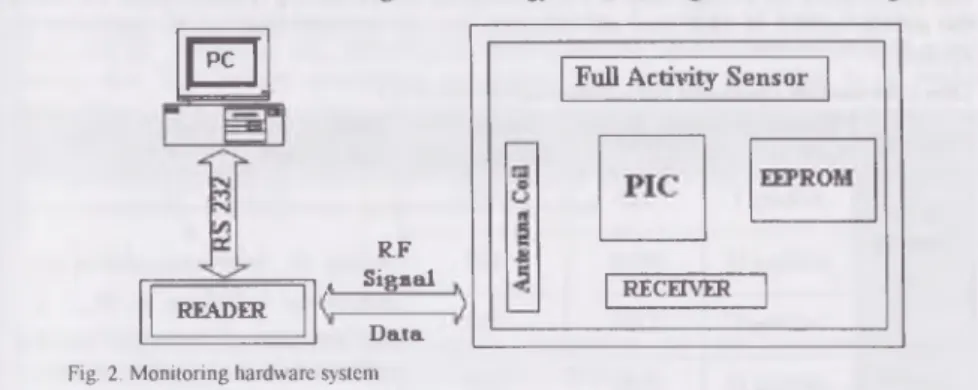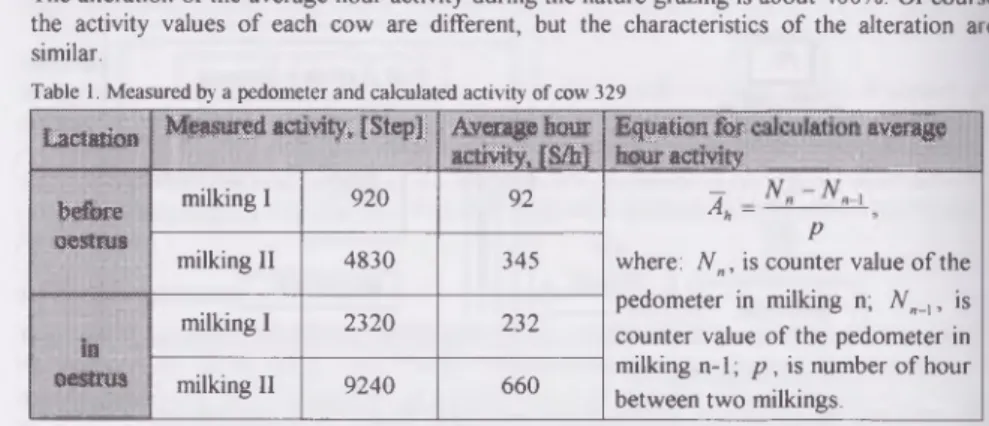Automated electronic activity measurement for oestrus detection of dairy cows
D i m i t a r R a d e v , I v a i l o S t o y a n o v , V e n e l i n J a k o v , U n i v e r s i t y o f R o u s s e , B u l g a r i a
Abstract
Sensor measurements o f the activity can be used in dairy cattle breeding fo r the detection o f oestrus. A new on-line information system has been developed in which the traditional pedometer is replaced by a sensor fo r fu ll activity (mobility). Results fo r the hour activity o f a dairy cow during different periods o f the lactation are presented. A recurrence hour activity model fo r detection is proposed. It is based on statistical analysis o f time series models and Kalman filter.
1 Introduction
Oestrus and diseases Oestrus, pregnancy,
otfvmg Oestrus end diseases
The help o f computer systems for observation o f animals is a basic premise for an increase of the productivity of the dairy cows. Sensor measurements are mostly used for detection of oestrus, pregnancy, early recognition o f mastitis and other diseases. The researches up to now o f Wendl (1998), Breme et al. (1999), Radev (1999) show that the parameters o f computer monitoring in the farming can be divided into two basic groups (see Figure 1).
Body sensors | Animai control i
Milk sensors | M^stij^.oestfusand
other diseases Mastitis, oestrus and
other diseases Mastitis, oestrus Fig. 1 Parameters of computerized process monitoring in dairy farms
Further efforts should be concentrated on the following objectives:
• Reducing the number o f the sensors on the body o f the animal - testing an
“integral sensor”;
• Development of “advanced sensors” especially when milking;
• Processing the data with the help o f intelligent systems.
The efforts of the University o f Rousse are concentrated on research o f a “full activity”
sensor, which is implemented in a system for automatic observation o f oestrus, as a first step along these lines.
2 Material and methods
The investigation takes into consideration the two characteristic periods o f dairy cow breeding in the Bulgarian farms:
• Winter - the classical technology for tied stall barn (November-March);
• Summer - most of the daytime the cows are out o f the cowshed at grass-feed (March- October). The milking is in the same way like in the tied stall barn (2-3 times daily).
158
An on-line oestrus monitoring system is developed Radev et al. (2000), in which the Iraditional pedometer is replaced by a “full activity” sensor. The data of the activity o f the examined cow are recorded and stored in EEPROM memory at every hour (see Figure 2).
Wireless transmission to the PC, using RF-technology is done during the time o f milking.
H .
RF READER
,4 Si3 aal D a ta
Full Activity Sensor
RECEIVER
Fig. 2. Monitoring hardware system
The management information system (MIS) automatically generates warning-lists at time of oestrus, which are based on signals, received from the sensor. MIS uses database in which the normal characteristics o f the measured variable are described. Each cow gets her own model of activity. The parameters o f the model are evaluated and corrected after each milking.
3 Hour activity of dairy cows
The investigation was carried out in an experimental farm of the Regional selection and reproduction department in Rousse for the period of one summer Sixteen Holstein Friesian cows were under observation around the oestrus days. Their activity is measured in two ways:
S by on-line monitoring system and attached to the cow’s neck a “full activity” sensor (Conrad Electronics N: 700444-25);
S by attached to the cow’s leg pedometer (type Zarya, Bulgaria), which with the help o f a mechanical counter gives the number of steps between two milkings.
The average hour activity Ah (in S/h) is calculated for comparison of the two activity models.
H our [h\
Fig.3. Hour activity of cow 329. measured by a “full activity” sensor: 1-normal rhythm. 2-rhythm in oestrus day
There are essential differences in the hour activity during the day in the cow breeding during the summer period. During the nature grazing (from 7 to 19 o ’clock) the “full activity” sensor detects an increase from about 600 to 1000% (see dependencel, Figure 3). These values are even bigger than the increase o f the activity rhythm during the nature grazing in oestrus day
159
(see dependence 2, Figure 3). The tendency although weakly expressed is observed also at measuring with a pedometer.
In the oestrus day the calculated hour activity increases between 150 and 300% (see Table 1) The alteration o f the average hour activity during the nature grazing is about 400%. O f course the activity values o f each cow are different, but the characteristics o f the alteration are similar.
Table 1. Measured by a pedometer and calculated activity of cow 329
Lactation M w w r ç âactivity [Step! • Average hour actpty, fS/h]
Bplfcioji >fer avsrags hour activity
before oestrus
milking I 920 92 2
h ~ P
where: N n, is counter value o f the pedometer in milking n; N H_]9is counter value o f the pedometer in milking n-1; / ?, is number o f hour between two milkings.
milking II 4830 345
in o e m m
milking I 2320 232
milking II 9240 660
Based on our results received from 462 milkings and 42 oestruses o f different cows, the following general conclusions can be made :
• During the nature grazing the cow activity increases considerably. The alterations in its normal behaviour rhythm are commensurable with the increase o f the activity in oestrus day. This can cause serious mistakes at generating o f the oestrus warning-list;
• With a pedometer the possibility for mistake at generating o f oestrus warning-list is bigger;
• The hour activity measurements give a more reliable and complete information than the measurements o f the number o f steps between two milkings.
• The possibility for integrating with other physiological parameters is the priority o f the
“full activity” sensor.
4 Time series models for oestrus
The information processing is based on statistical analysis o f time series combined with a Kalman filter. Such steady dynamic linear models (DLM), known also as Kalman filter are already used by Harrison and Stevens (1976) and Thysen (1993). We propose a Recurrence hour activity (RHA) model, which is based on dairy cows oestrus and diseases detection model (see De Mol et al., 1999):
Obser\>ation equation: Yn —C n.X n_ \ + V n\ (la )
System equation: X n = An.Xn-1 + Wn; (lb )
In these equations X nis the state vector, Y„the observation vector, C„ and A n are system matrices, V„ is the random observation error and Wn is the random system error. The system (lb ) gives the relation between the states at successive times. The distribution o f V„ and Wn is described by the vectors N (0, V„) and N (0, W„) respectively. Our information on-line system registers the activity o f each cow for every astronomical hour therefore the activity model becomes:
160
(2a) A 4 * ~ Ah n Ahn_2 - Z a n a .Z a
n_2
(2b)Where: Ah, is the average hour activity; A,, hour activity; k, number o f hours between two successive PC recordings; A Ah, difference of the average hour activity between milking n and milking n-2; Zo,„, random disturbance on average hour activity at milking n; a, model parameter.
We use an additional parameter // in the system vector to increase the accuracy of the model.
The hypothesis for average hour activity comparison at milking n and milking n-1 is checked by this parameter. The following vectors define the model:
- a ~AAh~ X /
Y = Z n =
r il -
n _AAn_ z - _
Where: AAn, is the average hour activity comparison in two successively on-line measurements; Z^n, random correlation on activity at milking n.
By observing the average activity correlation during two successive milkings, the possibility for mistake at generating o f oestrus warning-list decreases:
M , = - ~ - = z lt„ I (4)
Ah.n-\
The model estimation procedure is standard for the Kalman filter with two stages - estimation o f system vector X„ based at its previous state Xn.i\ updating the estimation with the observation Ynand estimating the error.
The accuracy of the proposed RHA model increases by increasing the number o f the observations on the measured variable. It is suitable to be used in intelligent system for on
line physiological parameters observation o f dairy cows (for instance body temperature, temperature and electrical conductivity of the milk, milk yield). The preliminary results, which have been obtained, give reasons to continue the research along these lines.
5 Reference
BREHME, U , BRUNSCH, R , SCHERPING, E„ WERNER, D (1999): Sensorgestützte Datenerfassung bei Rindern zur Weitemutzung im Herdenmanagement. Tagung Bau. Technik und Umwelt in der landwirtschaftlichen Nutztierhaltung, 09.-10.03.1999, Weihenstephan, 255- 260
HARRISON, P., STEVENS, C. (1976): Bayesian Forecasting (with discussion). Journal of the Royal Statistical Society, Series B, 38, 205-247
DE MOL, R., KEEN, A , KROEZE, G , ACHTEN, J. (1999): Description of a detection model for oestrus and diseases in dairy cattle based on time series analysis combined with a Kalman filter Computers and Electronics in Agriculture 22, 171-185
RADEV, D., (1999): A conception for a computer management in family dairy farms. Proceedings of Union of Scientists - Rousse, book 2: Technical Sciences, 49-52
RADEV, D., STOYANOV, I., (2000): Radiotelemetrical detection of moving objects. 21th International “Spring” Seminar on Semiconductor and Hybrid Technologies, Sofia (in press) THYSEN, I. (1993): Monitoring Bulk Tank Somatic Cell Counts by a Multi-Process Kalman Filter,
Animal Sc., 43, 58-64
WENDL, G., (1998): Elektronikeinsatz in der Rinderhaltung - von der Identifizierung bis zur Automatisierung. FAT-Schriflenreihe Nr: 47, Tänikon, Schweiz, 101-112
161

